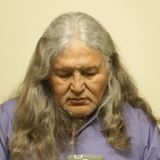By Dr. Erich Longie, Spirit Lake Dakota Nation
As was stated in a previous post ... The Dakota cultivated perseverance. Traditionally, rules were rules of survival and if they weren't followed, the whole tribe was at risk. Those who enforced the rules persevered in their chastisements until individuals conformed to the law. Without perseverance, the Dakota would not have survived the world they lived in. Their perseverance is one of the main reasons why their descendants are here today.
Fear is the greatest enemy of perseverance. There is the physical fear of being killed or injured by an enemy or wild animal. Another type of fear that persists today and relates to education is fear of failure, of not being able to measure up to expectations.
We were born during what many American Indians call the greatest generation, those in the 1940s and early 50s who overcame poverty, racism, alcoholism, lack of transportation to get an education, fight for a job within the system and bring jobs and self-governance to the reservations. This generation because of their perseverance brought much of the development we see on the reservations today - housing, manufacturing, tribal colleges -that overcame many barriers that benefit the reservation today. Prior to this generation, there was nothing on the reservation - no running water, no housing. This generation, in turn, opened the opportunities available to Indians now. We overcame the prejudice of the border towns, even the bad treatment of us when we went into the stores and restaurants in towns adjacent to the reservations. Why was our generation able to do that? Maybe because we were the first generation exposed to technology. We were exposed to television, gas stoves, etc. during our adolescence. As Edmunds (2001) noted, rural reservations were "inundated by a cultural invasion" that began with radio and television and has continued through videogames, the internet and social media.
A lot of us went to non-Indian schools off the reservation. We were put in the "slow" class with the poor white students. They never expected us to join the extra-curricular activities because they didn't think we were worth it. Yet, these same people were the ones who came back and started many of those improvements on the reservation. They didn't let the racism deter them.
Today reservations are a much better place to live than they were 150 years ago, 100 years and even 50 years ago when the author was a boy on the Spirit Lake Dakota Nation. There are better schools, there are jobs, and hardly anyone suffers from malnourishment. Yet, schools have a huge drop out rate. We propose a simple answer to the problem of academic achievement- return to the traditional value of perseverance. When the job becomes difficult some workers simply quit or do not attempt to look for work. The problem has become so severe on reservations that some casinos mandate an employee orientation for tribal members who have been fired or quit jobs at the organizations three or more times.
When adults no longer practice perseverance, we do not pass this virtue down to our children. As a result, when attending school becomes difficult or uninteresting, they simply do not attend. Research on one reservation found that the average student in elementary school missed an entire month of school (Longie,1995). A return to traditional values of perseverance and fortitude was hypothesized as a solution to this problem. Spirit Lake: The Game was developed by Dakota elders and tested with Dakota children in an effort to channel the new technology to benefit the next generation by integrating their traditional values, culture and history. In this manner, we follow in the footsteps of such Native American leaders as Yellowtail (Moxie & Bernardis, 2001) and Deer (Kidwell, 2001) who applied the education they learned in the white man's schools to defend and maintain the culture and sovereignty of their tribes.
REFERENCES
Edmunds, D. (2001). Twentieth-century warriors. In D. Edmunds (ed). The new warriors: Native American leaders since 1900. Lincoln: University of Nebraska Press, pp 1-16.
Hoxie, F. E. & Bernardis, T. (2001). Robert Yellowtail. In D. Edmunds (ed). The new warriors: Native American leaders since 1900. Lincoln: University of Nebraska Press, pp 55-78.
Kidwell, C. S. (2001). Ada Deer. In D. Edmunds (ed). The new warriors: Native American leaders since 1900. Lincoln: University of Nebraska Press, pp 239-262.
Longie, E. S. (1995). A Study of Attendance and Achievement Patterns among Eighth Grade American Indian and Non-American Indian Students on the Devils Lake Sioux Reservation (Master's Thesis, University of North Dakota, Grand Forks, North Dakota, 1995).

